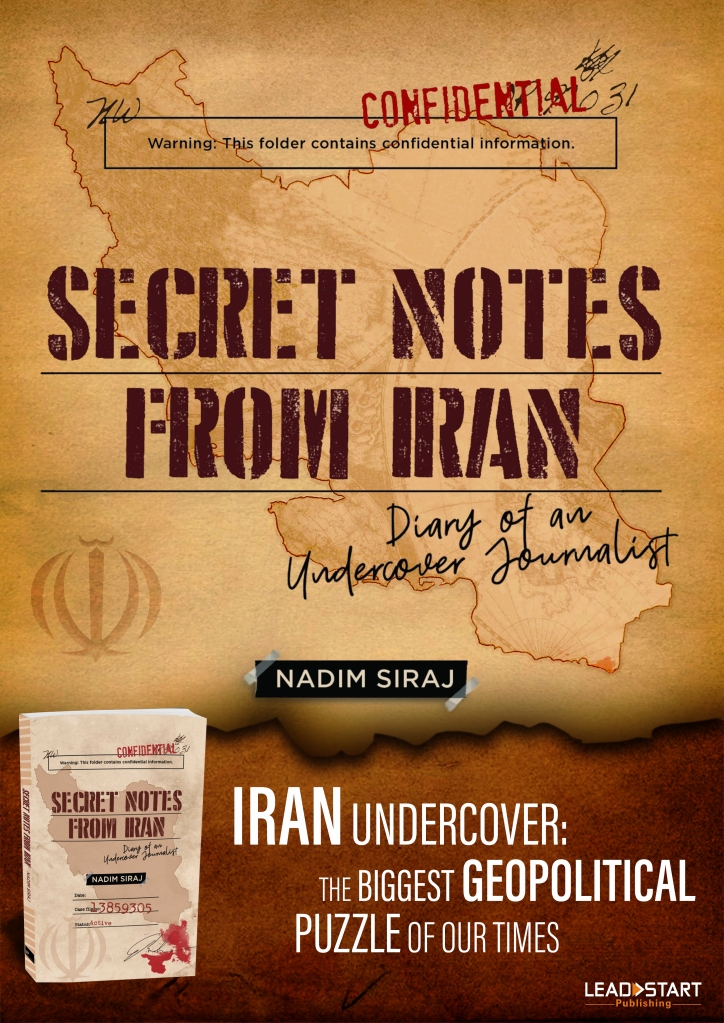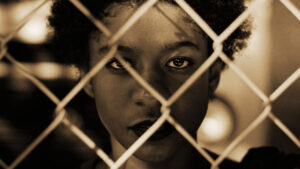
Protests across Iran, sparked by the killing of anti-headscarf activist Mahsa Amini at the hands of religious police, have escalated ever since the unpleasant episode, resulting in the deaths of dozens of women and more angry demonstrations seeking justice and a change in moral policing laws.
Here is a chapter from the 2019 book Secret Notes from Iran: Diary of an Undercover Journalist, written by Nadim Siraj, co-founder of Empire Diaries, and published by Leadstart Publishing under the imprint Platinum Press. The book is a ground report from the West Asian country. The following chapter from the book focuses on women in Iran and the politics surrounding them:
TO HELL WITH THE HEADSCARF
“Well-behaved women seldom make history.“
– Laurel Thatcher Ulrich, Pulitzer Prize-winning historian
Shiraz, Iran: It was a pleasant, atmospheric afternoon. A cool, stiff breeze was blowing in towards the marketplace at Vakil Bazaar, making the neatly planted trees at the complex break into a wobbly dance. After a long afternoon well spent in exploring the historic pebbled lanes and by-lanes of Vakil Bazaar in the heart of Iran’s garden city, Shiraz, I found the wind a welcome companion. Why not? It was trying to lull me into a nap on a wooden bench in one corner of the square.
Just as I was about to slip into sleep mode, I was startled by the sight of something astounding. Sleep went for a toss. An Iranian woman was blatantly taking off her mandatory headscarf and flaunting her peroxide-highlighted hair, in full public glare.
Chutzpah! Sheer defiance.
For any woman, appearing in public without the mandatory headscarf (rousari in Persian), is treated in the regime of Ayatollah Ali Khamenei, the Supreme Leader, as a serious criminal offence. The headscarf is a legal requirement, punishable by hefty fines or rigorous imprisonment for repeat offenders. Unreasonable as it may sound, the law has been firmly in place since the early 1980s, since after the Shia orthodoxy, led by Ayatollah Ruhollah Khomeini, came to power in 1979.
But wherever there is a regressive regime, there would be acts of defiance. Like the one that was unfolding before my disbelieving eyes.
The lady who stole the thunder seemed to be in her 20s. Sporting a white summery top, a pair of faded jeans and a silken blue-andwhite rousari, she walked out of the arched entrance of Vakil Bazaar, accompanied by a young man in casuals and shades. The duo was having a light-hearted chat when the lady playfully untangled the rousari from around her neck and pulled it off her head. Facing the hard breeze, she joyously held the scarf high up above her head with outstretched arms and ambled on. The rousari fluttered in the wind, like her golden hair.
That’s called throwing caution to the winds! Her companion, enjoying the sight, took out his mobile phone and snapped a few clicks as keepsakes.
Amazed and somewhat alarmed (wondering if the moral cops would swoop in and whisk the woman away), I looked around to figure out how the people around her were reacting to the shocking act of defiance. Passersby who crossed her path, gave the audacious lawbreaker a long, hard look, as did many of the shopkeepers along the outer wall of Vakil Bazaar.
The woman at the centre of the storm was unperturbed by the curious gazes. It was as if she were oblivious to the fact that she had just broken the law. After about half a minute or so (which felt timeless), she casually put the rousari back in place around her head and the duo disappeared somewhere into the crowd.
The troublemaker had left the spotlight. But many others of her nerve and verve were not stepping aside so quickly. The winds of change are here. And there’s a name for it now: ‘My Stealthy Freedom’.
That’s the big buzz these days in Iran. Wherever you find a gathering of young women, chances are you will hear the words, ‘My Stealthy Freedom’. You hear them in the beautiful gardens, in public squares, inside teahouses, around marketplaces, in residential neighbourhoods. And even in the power corridors of fortressed government buildings.
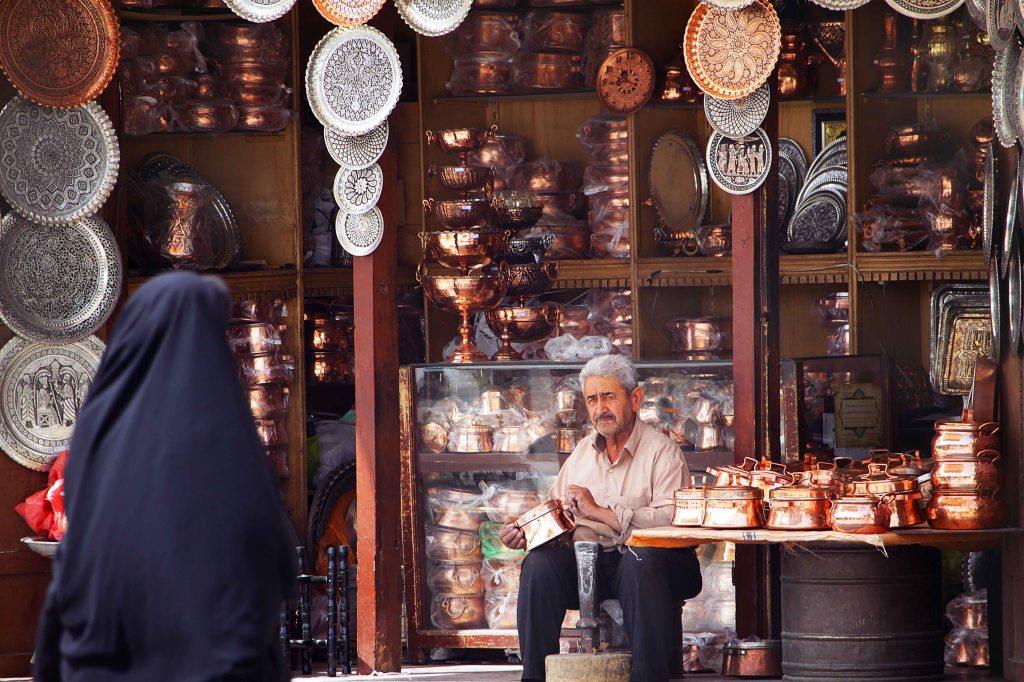
‘Stealthy’ Thunder
The last revolution the Iranians have witnessed is no longer the one that took place in 1979. It’s the one going on right now, having begun in the summer of 2014. That year, an enterprising Iranian journalist and social activist called Masoumeh Alinejad-Ghomi, affectionately hailed as Masih Alinejad, kick-started a controversial social media campaign that turned into a nationwide rage overnight.
From New York City, where Masih has been based for a long time, she launched ‘My Stealthy Freedom’, a social media campaign across multiple handles. In the campaign, Masih calls upon all the women in Iran to publicly or privately click photographs of their uncovered tresses and openly post them on My Stealthy Freedom’s social media platforms.
What was the idea behind the defiant act? A scathing message from all the women in Iran to their conservative government: To hell with the mandatory headscarf; to hell with your regressive law.
Soon after the campaign was launched, the Facebook page of My Stealthy Freedom was photo-bombed with scores of selfies of young Iranian women posing with their hair exposed. In many of the photos, the women have tried to be inventive and creative, striking stylish poses while throwing their rousaris up in the air. Most of the Iranian women who joined Masih’s social media revolution were youngsters.
While many of the photos posted online are casual selfies, some are well-staged shoots. In less than three years, My Stealthy Freedom’s Facebook page garnered a following of over a million people – mostly young Iranians, mostly women, but also Iranian men who detest the regressive dress code.
Riding the power and sway of social media in an Iranian society that is as hooked onto the online world, like any other part of the world, Masih’s movement has seen #MyStealthyFreedom turn into one of the most commonly used hashtags on the Internet.
As it happens whenever and wherever the winds of change blow, the anti-headscarf movement has been deluged with criticism. Most of the flak has expectedly come from the Shia orthodoxy that dominates Iranian society.
The government led by President Hassan Rouhani, and controlled by Supreme Leader Ali Khamenei, views the authenticity of the phenomenon with suspicion and has repeatedly questioned whether Masih’s efforts are indeed spontaneous or if the US government is fanning the fire.
It has not deterred the gritty Masih. Alongside the anti-headscarf movement, she runs another similar campaign, known as ‘White Wednesdays’. The idea behind this initiative is to tell the Iranian government that it needs to stop dictating the lives of ordinary women. The Iranian government repeatedly calls upon women to dress modestly whenever they are outdoors. In defiance, White Wednesdays involves women getting decked up in attractive, white dresses and posting selfies on the movement’s Facebook page.
It was not possible for me to catch up with Masih during my Iran trip as she lives in New York and is unlikely to be able to ever set foot on her native country’s soil, at least not as long as the Shia orthodoxy is in charge. So I worked out a long-distance interview with the young and chirpy revolutionary (see following chapter).
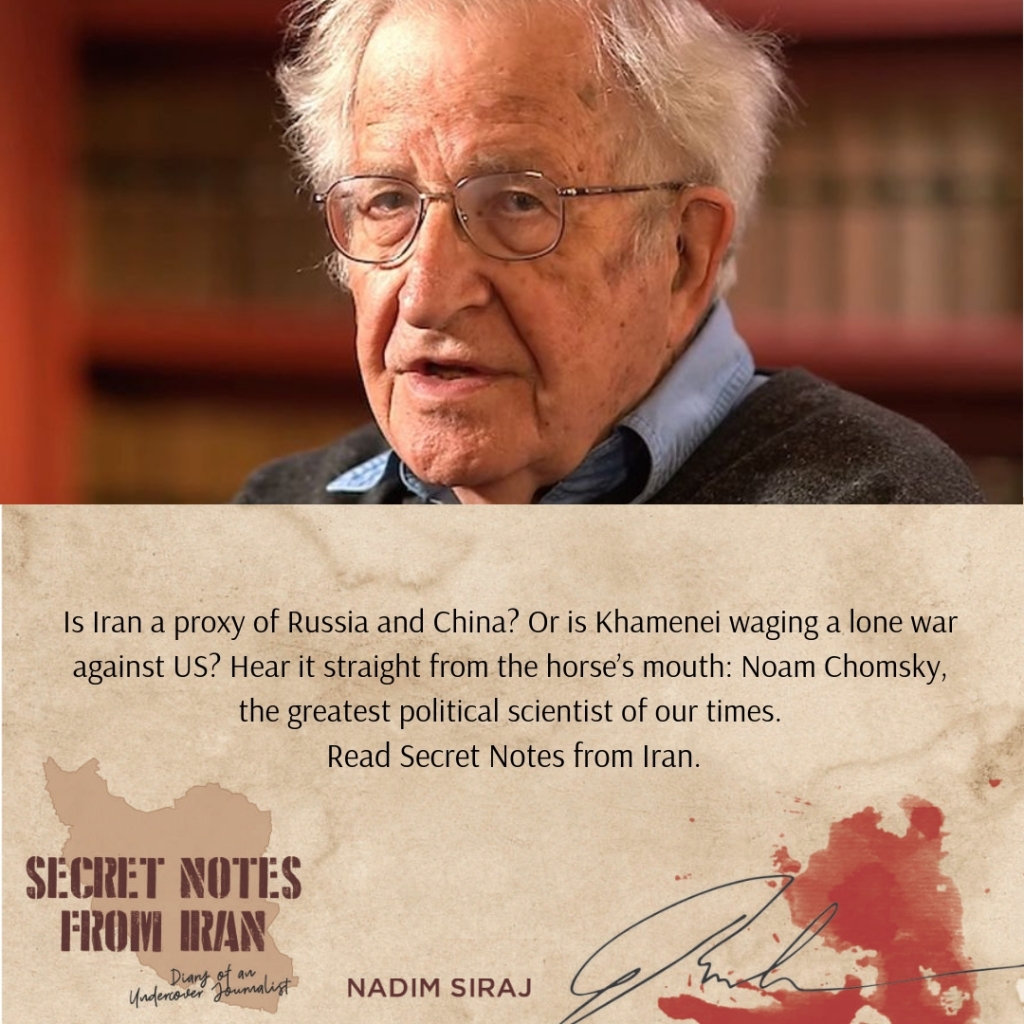
Needless to say, for the many women in Iran who participated in the anti-establishment campaigns, it was not a cakewalk. Scores who championed Masih’s cause have been arrested by the cops. Many still languish in jails all over Iran.
The pitched battle between the defiant Iranian women and the rigid government peaked in December 2017, when simmering tensions turned into full-scale protests that spilled out onto the streets of all the major cities. The hyperactivity was not just restricted to Tehran, traditionally referred to as the protest hub of Iran. A lot of global attention focussed on Enqelab Street in central Tehran.
Right through December 2017, when multi-agenda protests (against income inequality, unemployment and economic downturn), raged across Iran, Enqelab Street was on primetime news as the Tehrani cops conducted a brutal crackdown on protestors.
Countless women were picked up by the cops for taking selfies with their rousaris off. When the global press, especially the Western media, started giving the clampdown much-needed coverage, the Iranian government began to soften its stand, freeing many of the female prisoners. But not all and Iran-based activists are constantly pursuing their release.
The spectacular challenge the women threw at the government during the tumultuous times of December 2017, caused media commentators to term it ‘Girls of Revolution Street’. In fact, Masih’s twin drives against the dress code are not the only movements that have set social media afire. A number of other initiatives have been sparked as well. LGBT campaigners in Iran opened a Facebook page, My Stealthy Homosexual Freedom, sharing sarcastic posts and photos of faces covered in rainbow flags.
In 2016, a group of Iranian men started a ‘Men in Headscarves’ online campaign, where they expressed their thoughts on the anti-headscarf drive and posted tongue-in-cheek selfies by wearing rousaris themselves.
Not all the social media campaigns are bashing the government. There are a few that are going against the tide and supporting the Ali Khamenei regime, although they haven’t made much of an impact. One is an online effort called ‘Beautiful Headscarf, My Right, My Choice, My Life’. The participants uphold and celebrate the government’s stand on the mandatory rousari and call My Stealthy Freedom a cultural war on Iran.
Dresses For The Tresses
It is worth noting here that the entire Western press, including the top international news agencies, perpetually use an incorrect word to describe the Iranian headscarf. The global media calls it hijab, the Arabic word for headscarf. In the Arab world, known as the MENA region (Middle-East & North Africa), where Arabic is the dominant language, the headscarf is called hijab.
In Iran, Persian (or Farsi) is the only language that holds sway and the Persian word for headscarf is rousari. The paradox is that many Iranians themselves refer to the rousari as hijab in their interactions with the outside world because of the sheer popularity of the Arabic word.
Talking about headscarves and conservatism, rousaris are worn by those women who are at the progressive end of the spectrum in Iran. Take a walk down the busy streets of Tehran, or the bustling bazaars of Isfahan, or the gardens of Shiraz, and you will be amazed to find a large number of young Iranian women in dashing clothes and heavy makeup.
Rousaris, with their silken and multi-coloured look-and-feel, have been spun into a fashion statement. Many women sport tight, trendy denim wear in public, along with body-hugging tops that typically cover the elbows. Young women consciously wear headscarves as loosely as possibly, often deliberately baring prominent wisps of hair.
The rousari is accompanied by the stylish and attractive manteau, an extremely lightweight, button-less, front-open overcoat that runs down to the thighs. The combination of blue jeans, silken rousaris and colourful, fluttering manteaus is a favourite with the young crowd.
In fact, as I noticed at many public places in Iran, policewomen (who are moral watchdogs), are routinely on the beat to keep an eye on the ordinary women. At first glance, it wasn’t easy to identify the moral cops on the prowl, but when I actually started looking out for them as I travelled around Iran, I began noticing their ‘omnipresence’. I spotted them at public squares, parks, bazaars and crossroads; not in prominent groups, but randomly scattered.
The rousari is accompanied by the stylish and attractive manteau, an extremely lightweight, button-less, front-open overcoat that runs down to the thighs. The combination of blue jeans, silken rousaris and colourful, fluttering manteaus is a favourite with the young crowd.
Usually dressed in black chadors (full-length, loose-fitting shrouds), the policewomen slowly walk around keeping a hawk’s eye on possible violations of the dress code. Those ladies found to be pushing the envelope a little too much, usually by letting their rousaris drop back to bare their tresses, get politely ticked off by the moral cops. Such small instances are commonplace in Iran. They usually do not snowball into serious action.
While the progressive end of the scale is about stylish rousaris and gorgeous manteaus, at the opposite end there’s the uninspiring, pitchblack chador. The chador basically symbolizes the conservative side of Iran. It’s a head-to-toe, shapeless cloak that orthodox and elderly women, and moral policewomen, wear in public.
Chadors don’t have buttons. The front is open and the women use their covered hands (from inside the chador), to pull the shroud together as they go about their daily chores. In conservative parts of the country like Mashhad, Qom and Yazd, the chador and maqna-e (a nun-like, one-piece garment that covers a woman’s head and shoulders), are ubiquitous.
For first-time visitors to Iran, chadors and conservatively-worn rousaris and manteaus stand out in stark contrast to the vibrant and highly tasteful art, architecture and culture that Iran possesses and represents. Iran is an unusually seamless blend of two extremes. Classical art, rich literature, exotic cuisine and world-class filmmaking on one hand; strict religious policing and a poor human rights record on the other.
The attire Iranian women wear also reflects the political entity that dominates the country. When an orthodox political faction is ascendant, the women appear in public conservatively dressed. On the other hand, when more lenient reformers dominate the public space, the rousaris are worn boldly and stylishly, and the manteaus become playful and bright.

When Headscarves Were Banned!
The raging debate surrounding the mandatory headscarf is well known. What is not so well known is the irony behind the history of the rousari. Incredible as it may sound today, there was a time in Iran when moral cops were deployed on the streets and in public places to catch hold of conservatively dressed women and forcibly take their headscarves off! That was the law of the land between 1936 and 1941, when Reza Shah, the first of the Pahlavi rulers, was in command of the Imperial State of Iran.
The anti-rousari law, which was announced as a special decree on 8 January 1936, was a diametrically opposite dress-code dictatorship. As a result of the blanket ban on headscarves, many Iranian women reluctantly chose to spend their lives indoors, to avoid confronting the moral police on the streets.
That spell didn’t last long. When Reza Shah lost power and his son Mohammad Reza Shah took over the reins in 1941, the new boss immediately hacked the dress code. There was no longer any mandatory diktat regarding the rousari. To wear it or not was entirely a matter of personal choice. That phase of non-interference in women’s attire lasted till 1979, when Ayatollah Ruhollah Khomeini stormed to power following the Iranian Revolution. Khomeini made the rousari compulsory, and since then the regressive law has lasted nearly 40 years. The mandatory headscarf is symbolic of the larger restrictions women face in Iran.
It is something I got further confirmation of while chatting with Shervin Jahandar, a young businessman, and his sister Payvand, at a lovely little typically Shirazi teahouse near Vakil Bazaar. The Jahandar siblings hail from a well-to-do business family in the outskirts of Shiraz. The family has been in copper export for a quarter century. But Shervin and Payvand, both in their 20s, are desperately looking to “settle somewhere abroad”, to avoid living under a regime that tries to micromanage the lives of women.
“It’s not that we don’t like the family business,” explained Shervin. “Business runs the engine! But there’s something wrong here, which my sister can express better. There are restrictions here that you won’t find in most other places in the world. I have travelled to many countries. Out there, no one tells you ‘wear this’, ‘don’t do that’. Nobody interferes in your life.”
I reminded the upcoming copper baron about places like the Gulf countries that are much worse, outweighing Iran in terms of government domination of social life. Shervin agreed, but he made a valid point. “Take, for example, football games. My sister is fond of football. We are both crazy about the English Premier League and we follow the local football scene here. But I am not allowed to take her to the local games,” he complained. “You want to know more? She likes to sing and play the guitar. But she has to do it either indoors or with bands. She’s not allowed to do solo performances in public.”
No wonder there’s a steady stream of youngsters like the Jahandars of Shiraz, leaving Iran and settling down in North America and Europe, to win back their ‘social freedoms’. There’s a clear section of the new generation in Iran who feel they have a better future in the West. The new breed, especially young women, don’t mind giving up the hasslefree lifestyle, the wonderful parks and public squares, the buzz for high art and the generally crime-free city life in Iran, for personal freedom.
Turning The Tables
Unsavoury instances involving the lack of women’s rights in Iran often get reported globally. Among the most prominent instance involved Niloufar Ardalan, captain of the national women’s football team. Back in September 2015, Niloufar was forced to miss the Asian Championship’s final match, played in Malaysia. Iran eventually won that game and the trophy. Niloufar’s husband, Mehdi Tutunchi, a television sports presenter, exercised his civil right under Sharia law to get his wife debarred from leaving Iran without his permission. Infamously, Tutunchi claimed the sports event overlapped their son’s opening day at school.
The episode sparked raging debates worldwide, with prominent sportspersons, social activists and sports fans slamming the government for failing to come to Niloufar’s rescue.
Following pressure from various sections of the international community, the Ali Khamenei regime finally stepped in and ensured that Niloufar didn’t miss out on her next major sports assignment abroad. The judiciary allowed the national football skipper to obtain a travel visa (but only a single-exit one), without her husband’s consent being required. As a result, Niloufar was able to participate in the Iranian jersey at the Futsal World Cup in Guatemala in November 2015.
Singapore-based Straits Times published an AFP report on 24 November 2015 (Female Footballer Leaves Iran, After Court Overrules Her Husband’s Ban), claiming that the news about Niloufar being granted a visa to travel to Guatemala was first reported on a TV show called 90, aired on an Iranian state television channel. Under Sharia law, in place in Iran since 1979, any court in the country can upstage a man’s decision regarding his female family members.
There are some obvious women’s rights issues that are often talked about, like the inability to independently apply for visas, the regressive dress code, the ban on attending men’s sports events, and the restriction on solo artistic performances. But there are others that are lesser known to the wider world.
One is the divorce law and the complexities associated with it. In Iran, divorce cases are heard in claustrophobic bureaucratic-styled public courtrooms where the women have to take the lead and present their case with authority. The laws relating to divorce, domestic strife, inheritance and child custody rights blatantly favour men, which is why a woman has to go to great lengths to persuade the judge hearing her case to rule in her favour. That’s the norm. There have been several reported instances of divorce cases and domestic strife wrangles, when a male judge has rebuked the aggrieved woman for not trying hard enough to entice her husband back into the relationship – a typically patriarchal approach.
A 21 September 2015 report in the UK-based newspaper The Telegraph (Iran’s Big Woman Problem: All of the Things Iranian Women Aren’t Allowed to Do), compiled an interesting summary of the things that Iranian women are banned from doing.
According to the well-researched article written by David Blair, the patriarchal mindset in Iran doesn’t change even after a woman dies. If a woman dies in an accident or mishap, the deceased’s family gets only 50 percent of the compensation as compared to the death of a male family member. ‘Women are generally accepted in the work place, although there are restrictions,’ the Telegraph article claims. ‘Under Article 1117 of the Civil Code [that is followed by the Iranian government], any Iranian man has the right to ban his wife from working [professionally] if he thinks that it is incompatible with the interests of the family or his or his wife’s dignity.’
It’s not all doom and gloom though. Unlike in the ultra-conservative kingdom of Saudi Arabia, the adult female population of Iran is allowed to drive cars, eat out, go to the movies, move around with freedom and hang out with male friends in public places. I was particularly impressed with the number of young women hanging out with male companions at bazaars, public squares, teahouses and gardens. Especially in the three main cities – Tehran, Shiraz and Isfahan – little groups of women as well as families, are routinely seen late into the evening at eateries, high streets, parks and other public places.
It is necessary to mention here that unlike in the conservative Gulf kingdoms, Iranian women quite freely strike conversations with strangers in outdoor settings. The idea that Iranian women are usually reclusive is a myth, as I discovered myself. During the initial days of my tour, I dared not initiate a conversation with any female stranger. But to my surprise, it’s the Iranian women who, on many an occasion, themselves walked up to me and started a conversation.
There are no bans or restrictions for women on the two basic tiers of education in Iran – primary and secondary. When it comes to the universities, women dominate the registered student base. But, according to the Telegraph report cited above, there are several universities that disallow girls from pursuing certain subjects in the fields of technology and engineering.

Khamenei Plays Cupid
The government of Iran doesn’t just stop at deciding women’s dress code and their behaviour in public. The Ali Khamenei administration, in fact, goes as far as playing Cupid – trying its hand at a massscale, state-backed matchmaking initiative. Amusing as it may sound in countries where governments don’t micromanage people’s social lives, the Iranian state machinery, in June 2015, launched its very own matchmaking portal in a bid to inspire youngsters to avoid bachelorhood. Government officials announced that the goal was to help set up at least 100,000 marriages every subsequent year.
In an 8 July 2015 article (Iranian ‘Tinder’ Seeks to Encourage Marriage, But Not Dating), Time magazine reported; ‘Nearly half of the Iranian nationals in the age group of 18 to 35 years are unmarried. That comes to around 11 million people. So, the Tebyan Cultural and Information Center, a government-affiliated organization, launched a site in order to combat the rising trend among Iranian youth to avoid marriage.’
Time quotes Zohreh Hosseini, the government-run website’s project manager, who explains, “The median age for getting married in Tehran has reached 30 years for men and 28 years for women. This increases the chances of individuals never marrying. The alarm bells are ringing.”
Ironically, Iran had aggressively pursued a nationwide birth control programme for about 20 years. In the late 1980s, Ruhollah Khomeini issued fatwas (religious diktats), making means of birth control easily available in Iran. Since then, birth rates in the country have dipped noticeably. To arrest the slide, the Ali Khomenei regime decided to try reversing the trend by popularising the state-backed matchmaking drive.
There is another growing trend in urban Iran that prompted the administration to step in with this maverick programme. Many youngsters were uninterested in starting families. Instead, they preferred long-term dating relationships, resulting in a brisk growth in the number of live-in relationships in the cities, especially in Tehran. This phenomenon, known to Iranians as ‘white marriage’, has expectedly irked the dominant Shia orthodoxy.
Iranians who sign up with Hamsan.tebyan.net, the government-backed matchmaking hub, have to tackle lengthy questionnaires. They are told to undergo psychological tests and later appear for an interview. After that, the software takes charge, showing prospective matches that are cross-checked with mediators appointed by the administration.
Human Rights Watch (HRW), an extensively-followed rights violation watchdog, released a report in 2017, in which the Iranian government faced severe criticism for its scarred women’s rights record. In that ‘2017 World Report’, HRW states: ‘Iranian women face discrimination in personal status matters related to marriage, divorce, inheritance and child custody. The United Nations Children’s Rights Committee reported in March that the age of marriage for girls is 13 years, that sexual intercourse with girls as young as nine lunar years was not criminalised, and that judges had the discretion to release some perpetrators of so-called honour killings without any punishment. Child marriage, though not the norm, continues [in Iran], as the law allows girls to marry at 13 and boys at 15, as well as at younger ages if authorised by a judge.’
The civil rights scene for the female population is not in a good state either, if one is to go by a report circulated by the UNICEF in 2011. In that report titled Iran: Status of Girls and Women in the Middle East and North Africa, the UNICEF concludes: ‘An Iranian woman married to a foreign man is not allowed to pass on her nationality to their children. A child’s nationality is determined by the nationality of the father. A large number of children with Iranian mothers and Afghan fathers do not have a nationality. There are children who have Iranian mothers and Iraqi fathers who are unfortunately caught up in the same situation. An Iranian man can transfer his nationality to a nonIranian spouse. An Iranian woman is not allowed to do so. Before a court, a woman is not considered a full person. In most cases, a woman’s testimony is worth half of a man’s, and in some cases, a woman’s testimony is not accepted at all.’
Figures Don’t Lie
The outlook isn’t completely overcast for women, who won their right to vote in 1963. As of 2010, the women’s literacy percentage for those in the age bracket of 15 to 24 years, stood at an impressive 97.7%. That figure stood at 42.33% in 1979, which means it more than doubled between 1979 and 2010. Clearly, it is a sign of great progress, especially when compared to the (sorry) state of basic education in the Sunni Gulf kingdoms.
The literacy rate for females under 15 years of age stood at a staggering 79.23% in 2010, which is yet again a huge win as against the figures in the rest of West Asia, or even the Indian subcontinent. The figure was just 24.42% at the end of 1979, indicating a rapid rise in the state of education for women during the reign of the two Grand Ayatollahs – Ruhollah Khomeini and Ali Khamenei. The women’s illiteracy rate has gone down since 1970. At that time, it stood at 54%.
Fast forward to 2000, illiteracy fell to 17.3%. During the 1970s, the country featured among the top 10 nations of the world with respect to women’s literacy. Iran hung on to that position right up to 2011.
During a long spell from 1979 to 2010, the number of female graduates in Iran shot up 41 times. In 2010, Iran was home to 5.02 million female graduates as against just 122,753 in 1979. With a healthy spurt in the education level of females, the age for first marriage also went up to 23.4 years in 2010, as against 19.7 years in 1979.
The women’s education scene in Iran isn’t as bleak as it is often made out to be by the international press and Western watchdogs. In 2005, 65% of Iran’s university pupils and 43% of its salaried work force, were female. Surprising as it may sound, in early 2007, nearly 70% of Iran’s science and engineering pupils were women.
Through the 2000s, a remarkable 27.1% female ministers placed Iranians among the top 23 nations with regard to women’s role in governance. Currently, 29% of Tehran’s city council seats are held by women. Such vital pieces of information contradict the dark picture the Western press perpetually paints when it comes to women’s education in Iran.
Since the late 1970s, women in Iran literally exploded onto the scene in terms of grabbing jobs. The figures for women at work went up from 9.1% to 14% between 1996 and 2004, before eventually shooting up to 31.9% in 2009. As per figures released by the International Labour Organization, agriculture, education and manufacturing are the top three fields flaunting female employment in Iran.
For any country, a steady climb in the quantity of women getting topflight jobs, is a positive indicator of progress. But the trend didn’t go down well with certain sections of the Iranian government. The claim has been made by Washington-based think-tank Brookings Institution. In a report it published on 5 March 2008 (Are Iranian Women Overeducated?), Brookings claimed that Iran’s Parliamentary (Majles) Research Center conducted a study and was alarmed with the rapid increase in women’s enrolment across Iranian universities.
‘A brief note published on the website of Iran’s Parliamentary Research Center [in February 2008] raised a stir,’ states the Brookings report. ‘The note reported on the results of a study done by the Center on the rising enrollment of women in universities, but its tone was alarm instead of praise. The closing of the gender gap in education has been hailed as one of Iran’s important achievements. But inside Iran, there are concerns about women taking up precious spaces in universities.’
Brookings adds, ‘The [Parliamentary Research Center’s] note mentioned that to remedy the imbalance in enrollments, quotas had been in place for the entering classes in certain fields of study for two years. A week later, the BBC Persian service quoted an official who spoke of a plan to allocate 30% of the slots for men and women each and the rest to be decided competitively based on their scores.’
The fact that there are constant deliberations in government circles about the need to bring in minimum quotas for men in Iran’s universities (seems amusing), speaks volumes for the high degree of women’s penetration into the education system. At least, it holds true for Iran’s urban womenfolk.
Having lived in West Asia for close to a decade, I could easily gauge the high level of women’s involvement and exposure to mainstream society in Iran, in contrast with women in the Sunni kingdoms of the Gulf, where women are blatantly sidelined. Iran isn’t a Saudi Arabia or a Kuwait or a Qatar, where women invariably mother a number of kids and can only be seen at shopping malls and parks and recreational zones. No, it’s not a stereotype. It’s a reality across the oil-rich Gulf nations.
Iran stands out in the patriarchal super-society of West Asia, where you will find women prominently participating in the mainstream. But this observation holds true only for urban Iran. Rural Iran, as I myself discovered during my trip (and as you would figure out from many popular Iranian films), is on par with rural Gulf when it comes to women’s rights or the lack of it. The rural Iranian female population is as side tracked as the village women of the rich Gulf sheikhdoms.
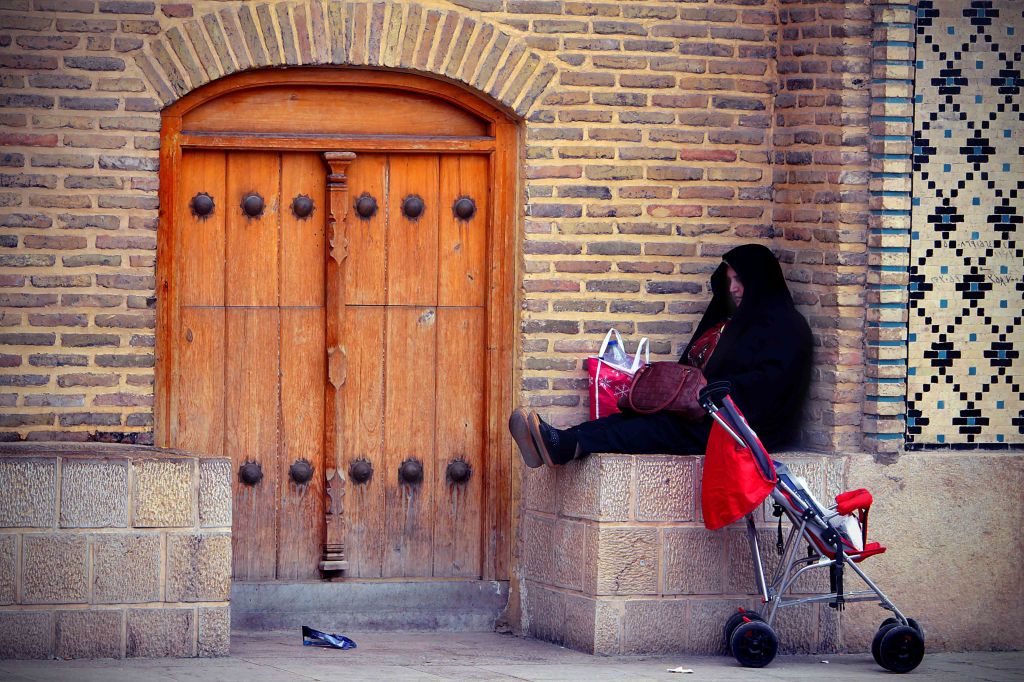
The Great Iranian Nose Job
As anywhere else in the world, Iranian women come with their own set of idiosyncrasies. One is the quintessential Iranian nose and a massive rage among the urban elite for nose-reshaping plastic surgeries. In an article published on 4 March 2013 (Iran is the nose job capital of the world with seven times more procedures than the US), The Daily Mail reported that the feverish rage for nose jobs among Iranian women has led to a nationwide spate of thousands of unauthorised practitioners, resulting in a prominent number of failed nose-reshaping attempts. ‘Iranian women strive for Hollywood button-nosed doll faces; [but] around 30% of the women who undergo the surgery are dissatisfied with the results; and a surge in popularity has led to an increase in [the number of] unlicensed practitioners and botched jobs,’ writes The Daily Mail.
In 2013, Iran won the enviable tag of the nose job capital of the world – with an unimaginable seven times more surgeries done than in the US. Cosmetic surgeries cost five to six times the average monthly income in Iran, but the Iranian local media reports that nearly 200,000 Iranians undergo nose jobs or rhinoplasty operations every year.
In Tehran alone, there were 157 licensed plastic surgeons in 2013, but there were over 7,000 unlicensed practitioners. Problems that result from botched nose jobs include respiratory trouble, denting or malformation, nasal congestion, growth of extra tissue and loss of smell.
Giving the fanaticism for nose jobs a run for its money is the Iranian women’s fascination for high-end make-up and expensive cosmetic products. In a news report published on 2 November 2016 (Iranians Spend $2.1 Billion on Beauty Products Annually), Financial Tribune reports: ‘There are 15 million cosmetic product users in Iran, which ranks second in the region after Saudi Arabia in the $7.2 billion beauty products market in the Middle East (West Asia).’
Going by figures obtained in 2016, Iranians spent 4.5% of their annual earnings on beauty products, three times more than their European counterparts. Germans spend 1.5% and the French and British 1.7% of their income every year on cosmetics. According to data collected by the IACTPI (Iranian Association of Cosmetics, Toiletries & Perfumery Importers), Iran accounts for $2.1 billion of West Asia’s bloated $7.2 billion glamour merchandise market.
As per the statistics gathered by the IACTPI, 70% of the cosmetic goods in the Iranian domestic market are basically smuggled products and they are sold at lower prices than they would be if they were legally imported.
It’s not always the case that Iranian women feel constantly straightjacketed by their government’s regressive, patriarchal policies. There are many who feel the Iranian women’s lifestyle and conditions are exaggerated by the international press. That’s something I learnt from Darya Shafaei, a middle-aged Iranian woman with whom I had an intense conversation on this topic, on a bus trip from Isfahan to Tehran.
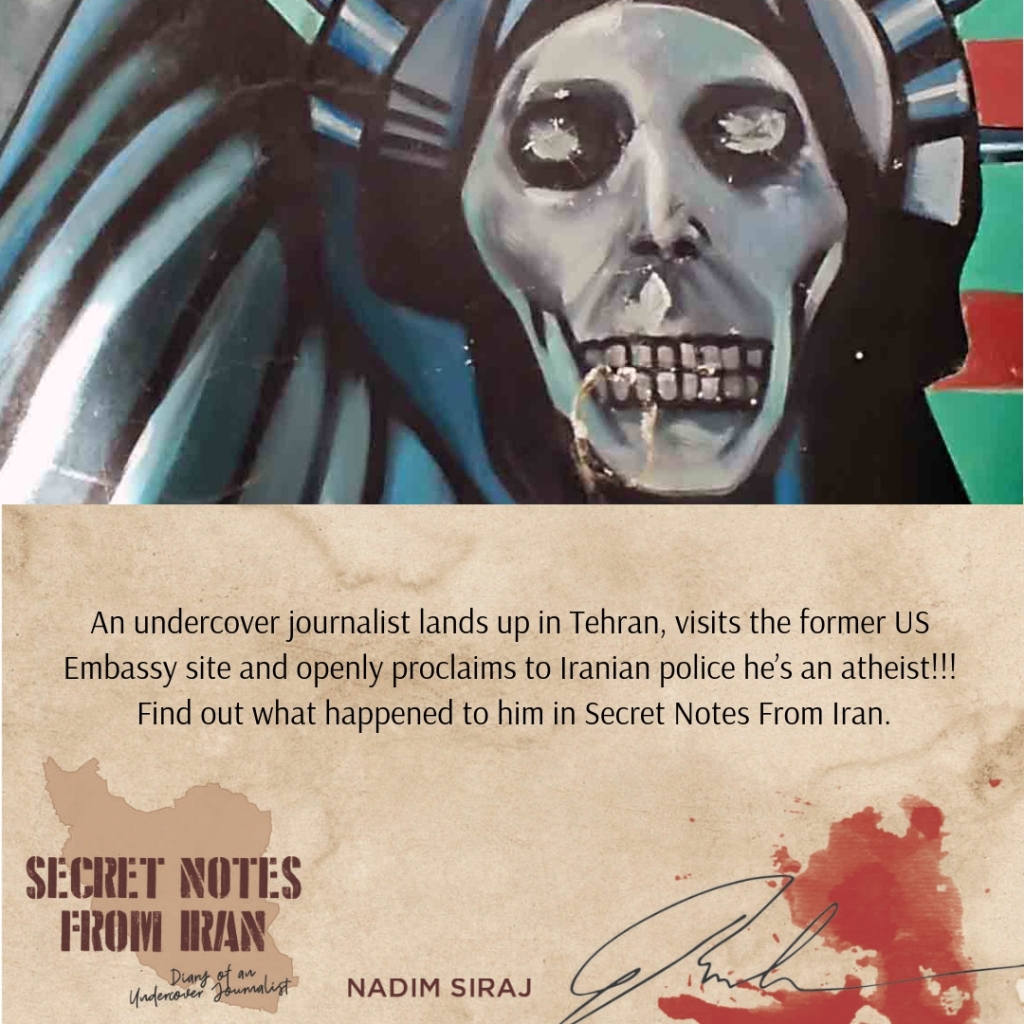
On Board A Magic Carpet
Long distance bus trips between the cities and towns of Iran make for an absolutely magical experience. Bus stations in the Iranian cities resemble airports. They are sprawling complexes, replete with little marketplaces and comfortable passenger waiting zones. When I dropped in at a bus station on a lazy Saturday morning in Isfahan, to book a ride to Tehran (a five-hour journey), I was amazed to see how well organized the place was. It appeared squeaky clean and way more impressive than many small-town airports in India.
I boarded a bus at 10.30am and we left following a delay of half an hour, and the subsequent five hours felt like I was flying on a Persian magic carpet, soaking in the sights and sounds of rural Iran. The views included rugged mountains, undulating sandy terrain, wide expanses of shrubbery, several desolate oil refineries and little hamlets on either side of the smooth highway.
The highlight of the journey was the stunning Hoz-e-Soltan Salt Lake, also known as Shahi Lake, which lies about 40km from the city of Qom. The lake had dried up at that time and only the salt and sand bed stood out, sizzling under the hard sun and appearing spectacularly fluorescent white as the bus meandered around it on way to Tehran. Shortly after bypassing the Hoz-e-Soltan Salt Lake, we had a welcome halt near an isolated petrol station.
After a quick lunch, comprising kebabs rolled in lightweight Iranian bread, I befriended Darya over a refreshing round of fruit juice. Darya hails from a business family in Tehran but lives in England with her husband and two kids. She teaches Persian (Farsi) at a private college in a leafy suburb of London, and her husband runs a Persian rug distribution network in the English capital. Darya has been living in the UK for over a decade but visits Iran almost every year to catch up with relatives and friends.
“The Western media has finished us,” lamented Darya when I asked her about the general perception that people in the UK have about Iranians.
“The newspapers and TV channels over there talk negatively about Iran all the time,” she complained, stressing ‘all the time’ with disgust. “People ask me, ‘Is it really dangerous to go to Iran?’ ‘What’s wrong with Iran?’ ‘Aren’t you lucky that you are not in Iran?’ ‘What about the dress code?’ ‘What happens to the women who flout the rules? Are they picked up from the streets and thrown into jail?’ Well, I get asked all sorts of scary questions. That’s simply because of the negative picture of Iran the press over there has created.”
“But isn’t some of it true?”
“Yes, but given the amount of negativity that’s attached to the daily news coverage of Iran, outsiders think Iran is a broken country. A dangerous country. It’s not the right assessment,” Darya contested. “Thanks to the English media, people in the UK learn about Iran only through news about the government creating problems, about demonstrations, women’s rights, religion, the rivalry with Saudi Arabia and all that talk about oil. Iran is not as bad as it seems from outside.”
Darya said she has battled all her life to change the perception.
“I have spent my lifetime telling friends outside Iran that most Iranian women lead a normal life. I am tired of fighting the Western press!”
The bus driver hollered at us to say it was time we got going. Darya and I wrapped up the chat and she passed on a few useful tips about where I would get the best saffron in the Grand Bazaar in Tehran. She pulled her loosened-up rousari tightly back into place over her head, carefully tucking the stray wisps of hair under the silken, dark green headgear before trotting back to the bus.
Darya calls it an exaggeration fanned by the Western media; many others call it a case of straightforward human rights violation. The debate surrounding the rousari continues to rage on. Given the controversy it keeps sparking, and the publicity it gets (good or bad), the Iranian headscarf is bound to keep the pot boiling in the days to come.
(This article is a chapter from the book Secret from Notes Iran: Diary of an Undercover Journalist. Prior permission of Leadstart Publishing is mandatory to republish/reproduce it in any form, in part or in full.)
